Abstract
AIMS: To determine the relation among the cytotoxin associated gene (cagA) and vacuolating cytotoxin gene (vacA) status of Helicobacter pylori isolates, the associated clinical diseases, and the severity and pattern of chronic gastritis. METHODS: Helicobacter pylori was cultured from gastric biopsies obtained from dyspeptic patients. DNA was extracted from the isolates and the cagA and vacA status determined by the polymerase chain reaction (PCR). The prevalence of the different cagA and vacA genotypes in three clinical groups, duodenal ulcer, gastric ulcer, and non-ulcer dyspepsia was compared. The histological features in sections from two antral and two corpus biopsies were graded by one blinded observer. The grades were compared with age and sex matched groups with different cagA and vacA genotypes, and with duodenal ulcers, or non-ulcer dyspepsia. RESULTS: Isolates from 161 patients were included. One hundred and nine (68%) harboured a cagA+ strain and 143 (89%) harboured a vacA s1 strain. The prevalence of cagA+ strains in duodenal ulcer patients (94%) was highly significantly greater than in those with non-ulcer dyspepsia (56%). However, of the patients infected with a cagA+ strain, almost equal numbers had non-ulcer dyspepsia or peptic ulceration. Chronic inflammation, polymorph activity, surface epithelial degeneration, atrophy, and intestinal metaplasia were all significantly more severe in the cagA+ than in the cagA- group, whereas only corpus epithelial degeneration was significantly more severe in the vacA s1 group compared with the vacA s2 group. Patients infected with cagA+ strains were almost four times more likely to have antral intestinal metaplasia than cagA- patients. An antral predominant gastritis was present in duodenal ulcer patients compared with matched non-ulcer dyspepsia patients, but this was not attributable to cagA or vacA status. CONCLUSIONS: Helicobacter pylori strains showing cagA positively and the vacA s1 genotype are associated with more severe gastritis but these virulence factors do not appear to determine the overall pattern. The pattern is closely linked to clinical disease. Therefore, it is likely that the nature of the disease complicating chronic infection is determined by host and environmental factors, while bacterial factors determine the magnitude of the risk of developing such disease.
Full text
PDF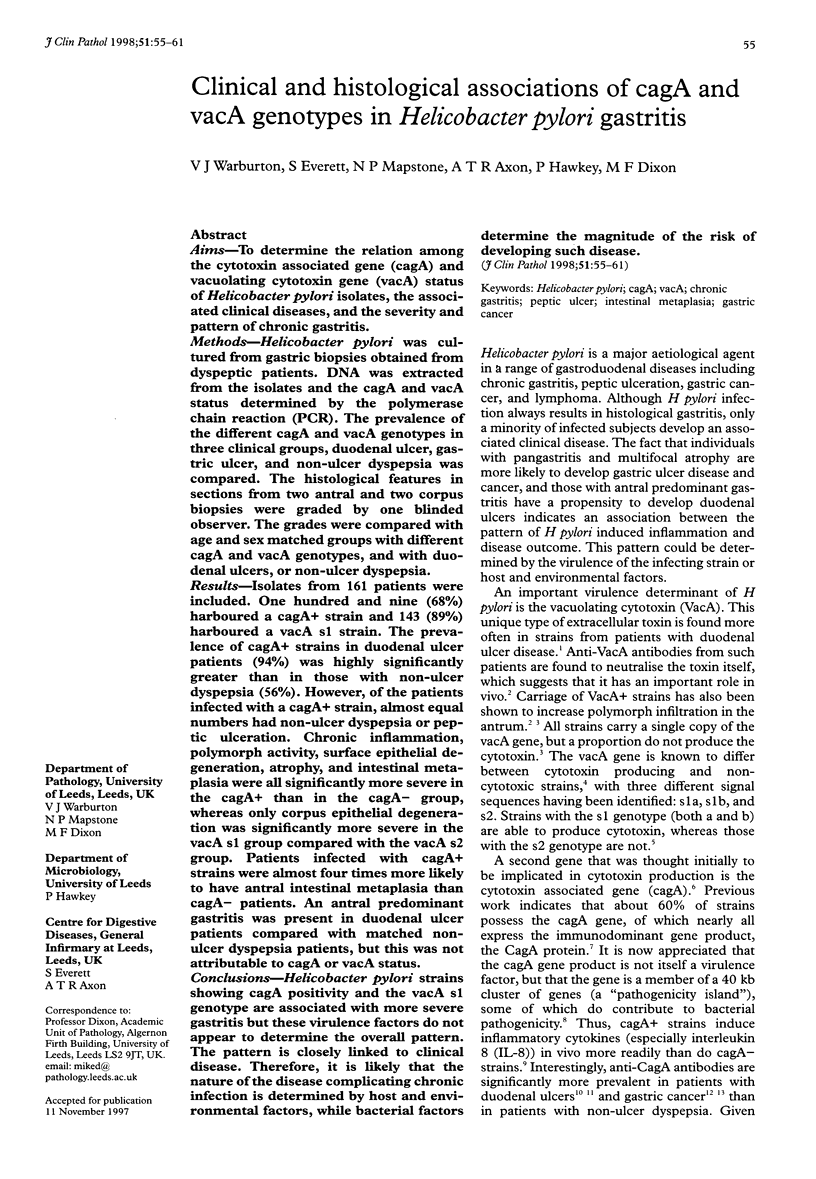
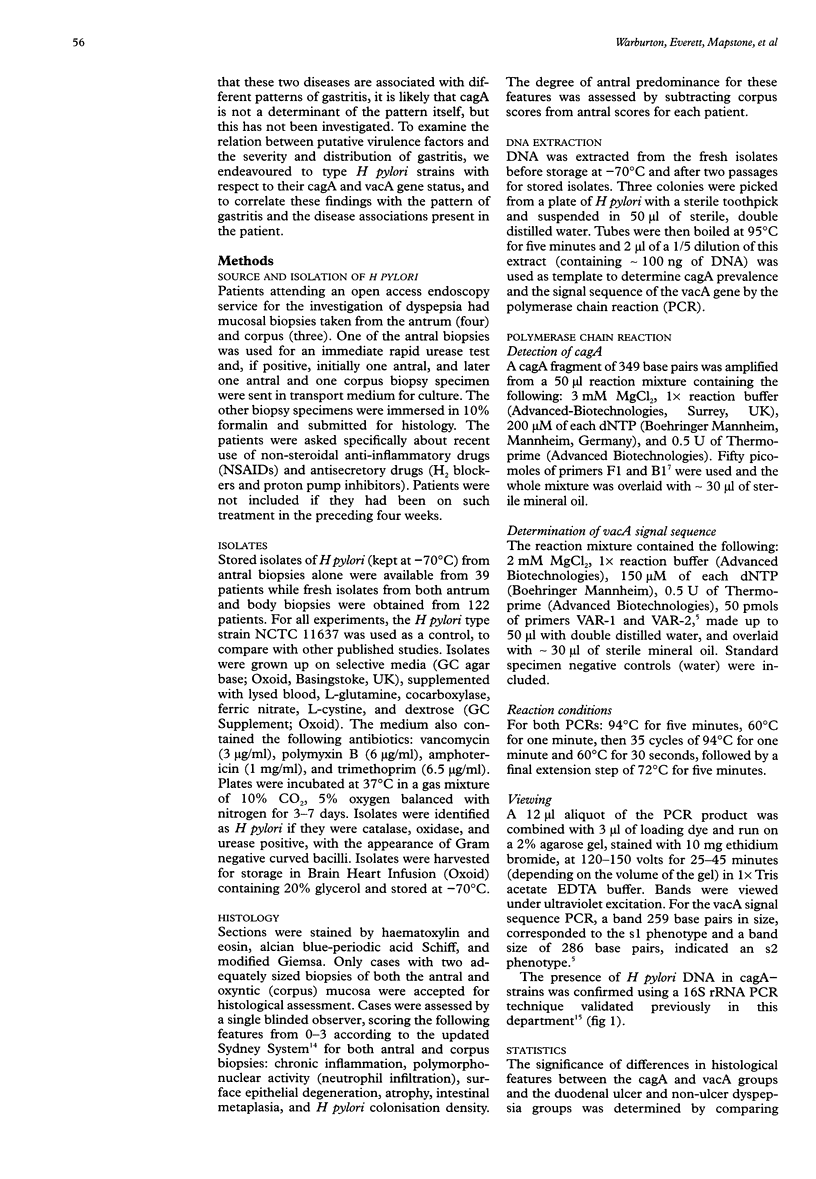

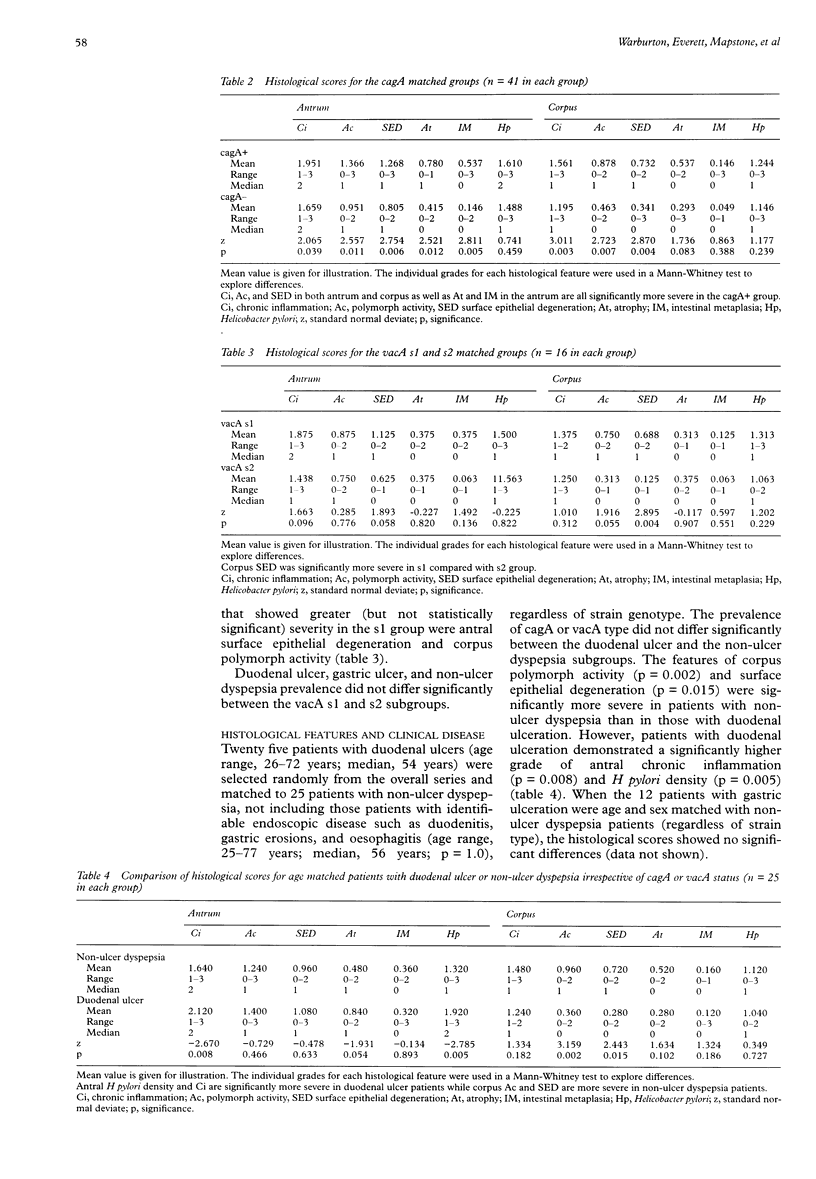
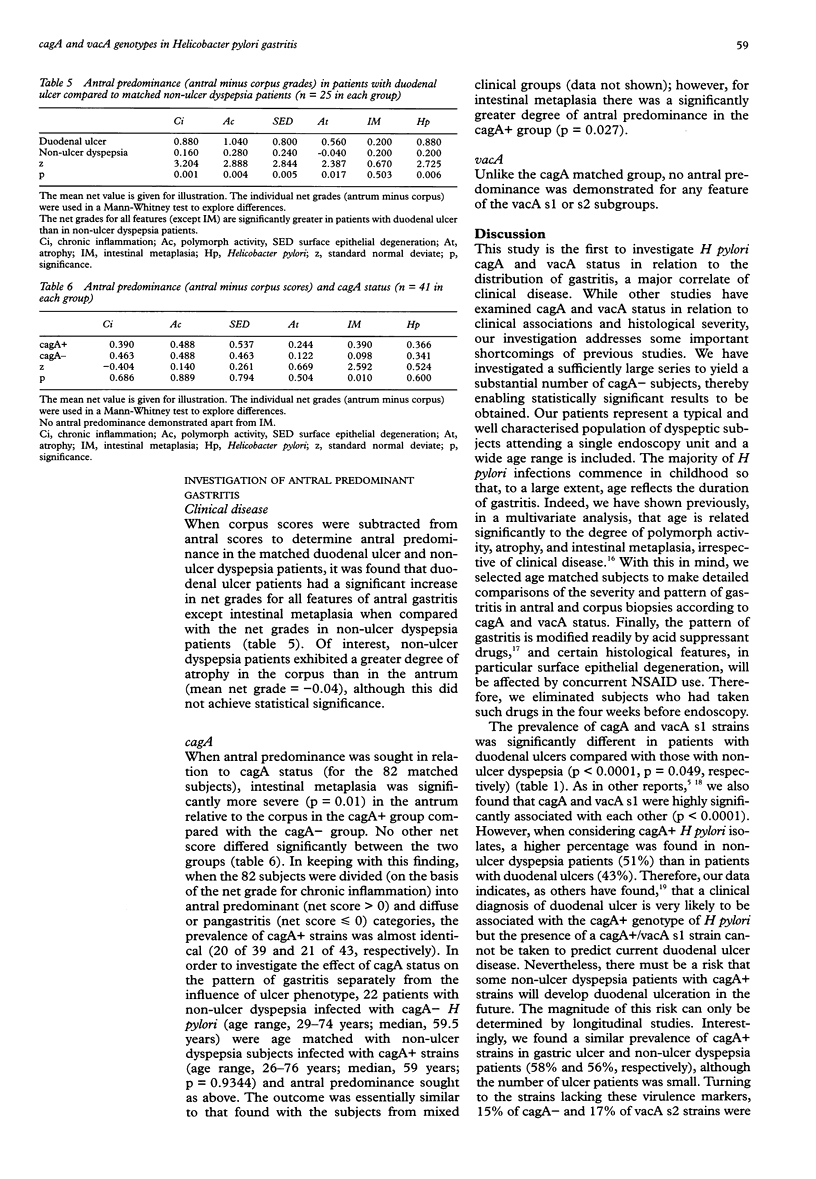
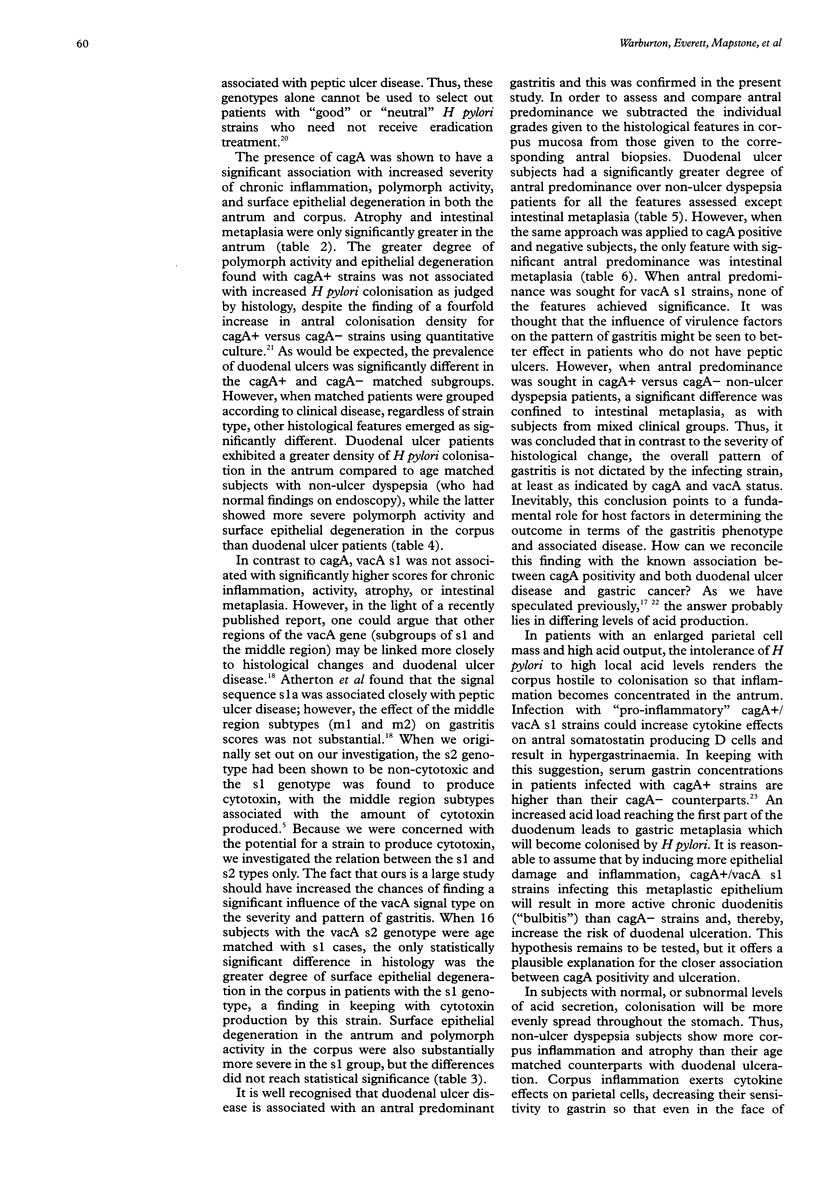
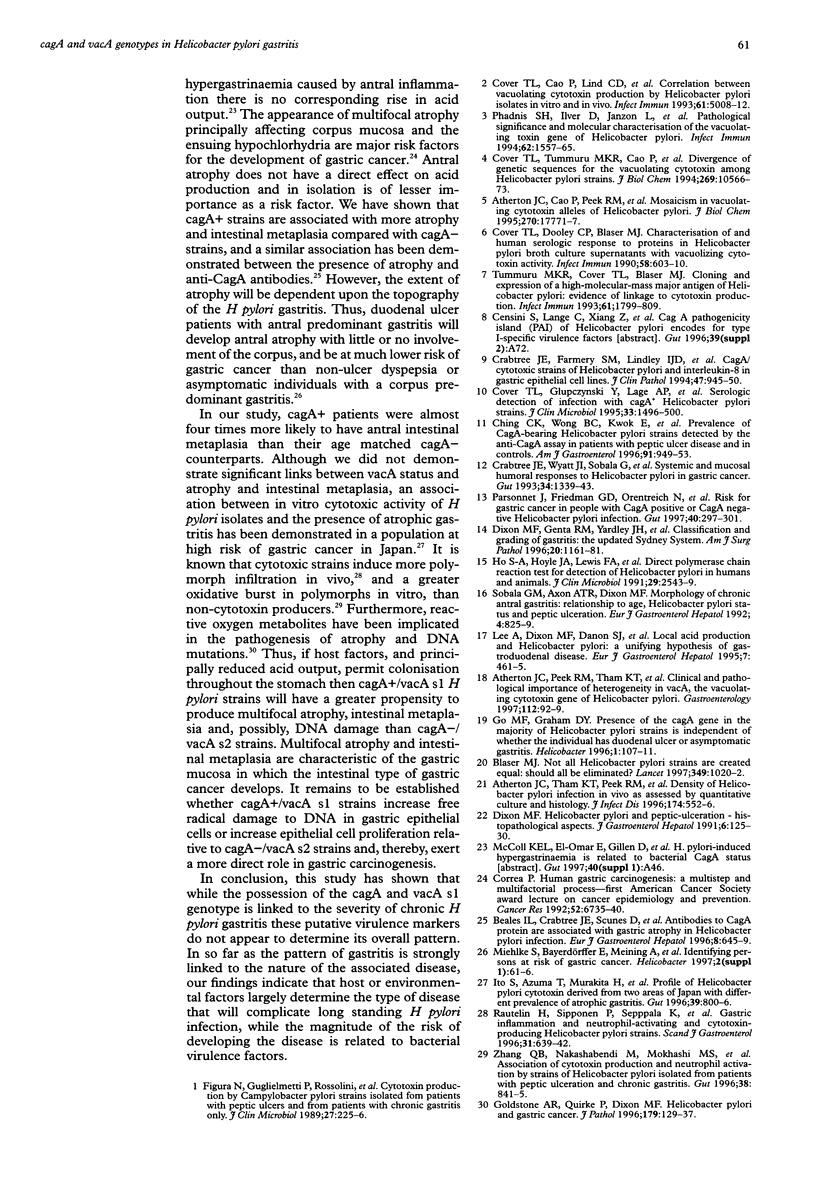
Images in this article
Selected References
These references are in PubMed. This may not be the complete list of references from this article.
- Atherton J. C., Cao P., Peek R. M., Jr, Tummuru M. K., Blaser M. J., Cover T. L. Mosaicism in vacuolating cytotoxin alleles of Helicobacter pylori. Association of specific vacA types with cytotoxin production and peptic ulceration. J Biol Chem. 1995 Jul 28;270(30):17771–17777. doi: 10.1074/jbc.270.30.17771. [DOI] [PubMed] [Google Scholar]
- Atherton J. C., Peek R. M., Jr, Tham K. T., Cover T. L., Blaser M. J. Clinical and pathological importance of heterogeneity in vacA, the vacuolating cytotoxin gene of Helicobacter pylori. Gastroenterology. 1997 Jan;112(1):92–99. doi: 10.1016/s0016-5085(97)70223-3. [DOI] [PubMed] [Google Scholar]
- Atherton J. C., Tham K. T., Peek R. M., Jr, Cover T. L., Blaser M. J. Density of Helicobacter pylori infection in vivo as assessed by quantitative culture and histology. J Infect Dis. 1996 Sep;174(3):552–556. doi: 10.1093/infdis/174.3.552. [DOI] [PubMed] [Google Scholar]
- Beales I. L., Crabtree J. E., Scunes D., Covacci A., Calam J. Antibodies to CagA protein are associated with gastric atrophy in Helicobacter pylori infection. Eur J Gastroenterol Hepatol. 1996 Jul;8(7):645–649. [PubMed] [Google Scholar]
- Blaser M. J. Not all Helicobacter pylori strains are created equal: should all be eliminated? Lancet. 1997 Apr 5;349(9057):1020–1022. doi: 10.1016/S0140-6736(96)09133-7. [DOI] [PubMed] [Google Scholar]
- Ching C. K., Wong B. C., Kwok E., Ong L., Covacci A., Lam S. K. Prevalence of CagA-bearing Helicobacter pylori strains detected by the anti-CagA assay in patients with peptic ulcer disease and in controls. Am J Gastroenterol. 1996 May;91(5):949–953. [PubMed] [Google Scholar]
- Correa P. Human gastric carcinogenesis: a multistep and multifactorial process--First American Cancer Society Award Lecture on Cancer Epidemiology and Prevention. Cancer Res. 1992 Dec 15;52(24):6735–6740. [PubMed] [Google Scholar]
- Cover T. L., Cao P., Lind C. D., Tham K. T., Blaser M. J. Correlation between vacuolating cytotoxin production by Helicobacter pylori isolates in vitro and in vivo. Infect Immun. 1993 Dec;61(12):5008–5012. doi: 10.1128/iai.61.12.5008-5012.1993. [DOI] [PMC free article] [PubMed] [Google Scholar]
- Cover T. L., Dooley C. P., Blaser M. J. Characterization of and human serologic response to proteins in Helicobacter pylori broth culture supernatants with vacuolizing cytotoxin activity. Infect Immun. 1990 Mar;58(3):603–610. doi: 10.1128/iai.58.3.603-610.1990. [DOI] [PMC free article] [PubMed] [Google Scholar]
- Cover T. L., Glupczynski Y., Lage A. P., Burette A., Tummuru M. K., Perez-Perez G. I., Blaser M. J. Serologic detection of infection with cagA+ Helicobacter pylori strains. J Clin Microbiol. 1995 Jun;33(6):1496–1500. doi: 10.1128/jcm.33.6.1496-1500.1995. [DOI] [PMC free article] [PubMed] [Google Scholar]
- Cover T. L., Tummuru M. K., Cao P., Thompson S. A., Blaser M. J. Divergence of genetic sequences for the vacuolating cytotoxin among Helicobacter pylori strains. J Biol Chem. 1994 Apr 8;269(14):10566–10573. [PubMed] [Google Scholar]
- Crabtree J. E., Farmery S. M., Lindley I. J., Figura N., Peichl P., Tompkins D. S. CagA/cytotoxic strains of Helicobacter pylori and interleukin-8 in gastric epithelial cell lines. J Clin Pathol. 1994 Oct;47(10):945–950. doi: 10.1136/jcp.47.10.945. [DOI] [PMC free article] [PubMed] [Google Scholar]
- Crabtree J. E., Wyatt J. I., Sobala G. M., Miller G., Tompkins D. S., Primrose J. N., Morgan A. G. Systemic and mucosal humoral responses to Helicobacter pylori in gastric cancer. Gut. 1993 Oct;34(10):1339–1343. doi: 10.1136/gut.34.10.1339. [DOI] [PMC free article] [PubMed] [Google Scholar]
- Dixon M. F., Genta R. M., Yardley J. H., Correa P. Classification and grading of gastritis. The updated Sydney System. International Workshop on the Histopathology of Gastritis, Houston 1994. Am J Surg Pathol. 1996 Oct;20(10):1161–1181. doi: 10.1097/00000478-199610000-00001. [DOI] [PubMed] [Google Scholar]
- Dixon M. F. Helicobacter pylori and peptic ulceration: histopathological aspects. J Gastroenterol Hepatol. 1991 Mar-Apr;6(2):125–130. doi: 10.1111/j.1440-1746.1991.tb01451.x. [DOI] [PubMed] [Google Scholar]
- Figura N., Guglielmetti P., Rossolini A., Barberi A., Cusi G., Musmanno R. A., Russi M., Quaranta S. Cytotoxin production by Campylobacter pylori strains isolated from patients with peptic ulcers and from patients with chronic gastritis only. J Clin Microbiol. 1989 Jan;27(1):225–226. doi: 10.1128/jcm.27.1.225-226.1989. [DOI] [PMC free article] [PubMed] [Google Scholar]
- Go M. F., Graham D. Y. Presence of the cagA gene in the majority of Helicobacter pylori strains is independent of whether the individual has duodenal ulcer or asymptomatic gastritis. Helicobacter. 1996 Jun;1(2):107–111. doi: 10.1111/j.1523-5378.1996.tb00019.x. [DOI] [PubMed] [Google Scholar]
- Goldstone A. R., Quirke P., Dixon M. F. Helicobacter pylori infection and gastric cancer. J Pathol. 1996 Jun;179(2):129–137. doi: 10.1002/(SICI)1096-9896(199606)179:2<129::AID-PATH504>3.0.CO;2-C. [DOI] [PubMed] [Google Scholar]
- Ho S. A., Hoyle J. A., Lewis F. A., Secker A. D., Cross D., Mapstone N. P., Dixon M. F., Wyatt J. I., Tompkins D. S., Taylor G. R. Direct polymerase chain reaction test for detection of Helicobacter pylori in humans and animals. J Clin Microbiol. 1991 Nov;29(11):2543–2549. doi: 10.1128/jcm.29.11.2543-2549.1991. [DOI] [PMC free article] [PubMed] [Google Scholar]
- Ito S., Azuma T., Murakita H., Hirai M., Miyaji H., Ito Y., Ohtaki Y., Yamazaki Y., Kuriyama M., Keida Y. Profile of Helicobacter pylori cytotoxin derived from two areas of Japan with different prevalence of atrophic gastritis. Gut. 1996 Dec;39(6):800–806. doi: 10.1136/gut.39.6.800. [DOI] [PMC free article] [PubMed] [Google Scholar]
- Lee A., Dixon M. F., Danon S. J., Kuipers E., Mégraud F., Larsson H., Mellgård B. Local acid production and Helicobacter pylori: a unifying hypothesis of gastroduodenal disease. Eur J Gastroenterol Hepatol. 1995 May;7(5):461–465. [PubMed] [Google Scholar]
- Parsonnet J., Friedman G. D., Orentreich N., Vogelman H. Risk for gastric cancer in people with CagA positive or CagA negative Helicobacter pylori infection. Gut. 1997 Mar;40(3):297–301. doi: 10.1136/gut.40.3.297. [DOI] [PMC free article] [PubMed] [Google Scholar]
- Phadnis S. H., Ilver D., Janzon L., Normark S., Westblom T. U. Pathological significance and molecular characterization of the vacuolating toxin gene of Helicobacter pylori. Infect Immun. 1994 May;62(5):1557–1565. doi: 10.1128/iai.62.5.1557-1565.1994. [DOI] [PMC free article] [PubMed] [Google Scholar]
- Rautelin H., Sipponen P., Seppälä K., Sarna S., Danielsson D., Kosunen T. U. Gastric inflammation and neutrophil-activating and cytotoxin-producing Helicobacter pylori strains. Scand J Gastroenterol. 1996 Jul;31(7):639–642. doi: 10.3109/00365529609009142. [DOI] [PubMed] [Google Scholar]
- Tummuru M. K., Cover T. L., Blaser M. J. Cloning and expression of a high-molecular-mass major antigen of Helicobacter pylori: evidence of linkage to cytotoxin production. Infect Immun. 1993 May;61(5):1799–1809. doi: 10.1128/iai.61.5.1799-1809.1993. [DOI] [PMC free article] [PubMed] [Google Scholar]
- Zhang Q. B., Nakashabendi I. M., Mokhashi M. S., Dawodu J. B., Gemmell C. G., Russell R. I. Association of cytotoxin production and neutrophil activation by strains of Helicobacter pylori isolated from patients with peptic ulceration and chronic gastritis. Gut. 1996 Jun;38(6):841–845. doi: 10.1136/gut.38.6.841. [DOI] [PMC free article] [PubMed] [Google Scholar]



